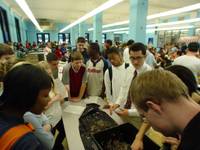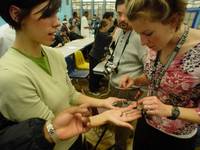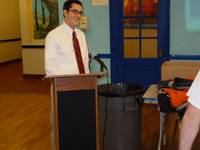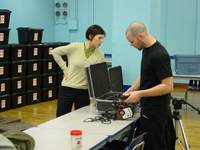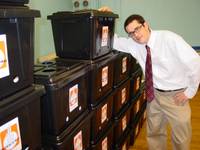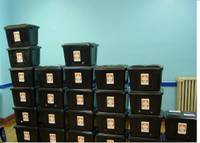The latest intel from around the triple W and from around your back yard. A collaborative news service where we actually admit that we filter and hand pick what we want you to read, from the concerned folks at Buckeye Sustainability Institute
NOTE: This News section may contain portions of copyrighted material. In accordance with Title 17 U.S.C. Section 107, such attributed material is available without profit to people expressing an interest in this information for research.
12.15.2005
Consumption of organic and ethical products on the rise
Full Text available : Drinks Business Review - USA
BSI note: Sammy Smiths has been churning out organic beers in the UK for a while now. This just in, our inside sources in the macrobrewing industry tell us that the country's largest American owned brewer may be positioning itself to launch an organic product in the future as well. I for one cant wait to see the commercials.
While it may be perplexing for some to see the big boys even thinking about brining eco_logical products to the market, consider the tipping point well off in the future and how benificial corporate america err responsable corporate america could be.
I'll drink to that. Now if our local "eco" brewer would even consider an organic product... that would be bOOoooOOmbastic~
12.01.2005
Friends of Coal & Toyota Off Road Team Up?

This image was spotted while traveling recently in southern indiana. 2004 Toyota SR5. prolly 14mpg ay? sends us your favorite gas guzzler shots. We may do something with em.
Wait folks, the fun doesnet just stop with the picture.. oo no :
First, one simply must visit the "Friends of Coal's website
Once you get to know em, you really must party with them!
Sustainability Business Worth $ Trillions
Press Release - United Nations Environment Programme
A powerful alignment of legal, financial, and investment interests will see USD trillions directed in the next decade to evolving markets linked to climate change, clean technology and sustainable use of natural resources, a report being prepared for the United Nations predicts.
"The Working Capital Report", to be published for the first time in March 2006 by the United Nations Environment Programme Finance Initiative, is the culmination of a series of landmark studies undertaken during 2004-5.
This series of UN-backed studies explores the role of financial service companies and capital markets, and the legal context in which they operate, as they capitalise on new opportunities linked to the concept of sustainable development and more effective management of associated risks.
"There is no question that 2005 will be seen as the watershed when the mainstream banking, insurance and investment worlds realised the scale of the commercial opportunities unfolding in the new carbon, clean-tech and sustainable natural resource markets and, also, the legal risks of not being a leader in this area," explained Klaus Toepfer, Executive Director of the United Nations Environment Programme.
Full Text available by clicking here!
SC Johnson, EPA Partner to Design Eco-Products for the Home
GreenBiz.com, 30 November 2005 - SC Johnson has entered into a voluntary partnership with The United States Environmental Protection Agency (EPA) under the agency's Design for the Environment (DfE) Program.
SC Johnson is the first major consumer packaged goods company to partner with EPA on the program, which promotes innovative chemical products, technologies, and practices that benefit human health and the environment.
The wide-ranging partnership recognizes SC Johnson's long-standing commitment to formulate its products with more environmentally preferred ingredients. It also makes provisions for the company to further work with EPA chemists, environmental scientists and risk reduction staff in investigating materials that can further improve the health and environmental profiles of the company's products.
SC Johnson Chairman and CEO Fisk Johnson stated his enthusiasm for the partnership. "We are delighted to continue to partner with the EPA. Design for the Environment supports SC Johnson's commitment to put the environment and human health at the center of product development and formulation. Companies can and should continue to look closely at making investments that are about doing what's right for the business and the environment."
The DfE Program is one of EPA's premier partnership programs, working with individual companies and industry sectors to compare and improve the performance and human health and environmental risks and costs of existing and alternative products, processes and practices. DfE partnership projects promote continuous improvement, integrating more environmentally responsible solutions into everyday business practices.
The Memorandum of Understanding states, "SCJ and DfE are aligned in their ways of assessing and evaluating the potential health and environmental effects of consumer cleaning products, SCJ through its Greenlist process and DfE through its comparative ingredient assessments."
SC Johnson's Greenlist process ensures that the company's products contain materials that are the best available for the environment and consumers without compromising performance, aesthetics, or cost to consumers. The process goes beyond the normal risk assessments and regulatory requirements to evaluate each raw material in every SC Johnson product.
11.27.2005
New S.F. aquarium will be largest 'green' building
10,000 animals, is coming to San Francisco.
On Sept. 14, construction workers broke ground on the new California Academy of Sciences Steinhart Aquarium building, slated to open in Golden Gate Park in late 2008. A key aspect of the $392 million project is its "green" design, which will make the building itself one of the academy's main exhibits.
"San Francisco is the perfect place to do this," said Steinhart Aquarium Director Dr. Christopher Andrews, referring to the culture of environmental concern prevalent in the city. "Much of what the building will speak to is the need for conservation."
The new academy's design, which earned it the Holcim Award for Sustainable Construction, includes solar panels that will provide about 5 percent of the building's power and a "living roof" covered with 1.7 million native plants in six inches of topsoil, which will soak up about half of the rainwater that falls on the building, significantly reducing runoff. The other half will be caught in reservoirs and used as non-potable waste water.
Including the concrete and steel, all of the materials from the old location were recycled, and the academy will use all recycled steel in its new building.
Exhibits at the new California Academy of Sciences Steinhart Aquarium will include old favorites, such as the alligator-inhabited "swamp" near the museum's entrance and the African penguins, as well as several new projects.
"The need for change is key to keep people coming back," Andrews said.
Among the new attractions will be a 90-foot-tall "Rainforest Dome," which will have a living Amazonian rain forest on one side and galleries devoted to rain forests in Borneo, Costa Rica and Madagascar on the other. A three-level walkway will wind its way to the top of the dome, where visitors can board an elevator to a glass tunnel leading through the 100,000-gallon flooded Amazon rain forest tank.
Another icon of the new aquarium will be a 225,000-gallon living coral reef tank. The 20-foot-deep tank will cover
12,000 square feet and feature aquatic life and mangroves from the Philippines. The
living coral reef exhibit will be the first of its size in the United States, an ambitious undertaking that brings new challenges.
"Most of the reef is sustained by light," said aquarium curator Bart Shepherd, who was instrumental in designing the smaller coral reef at the aquarium's current location and is working on the new one. "Our biggest challenge has been providing appropriate light."
Shepherd said the only light bulbs that will work for the new coral reef are not typically found in U.S. aquariums but are the massive halides used to light stadiums.
The Steinhart Aquarium originally opened in Golden Gate Park in 1923 and moved to its temporary location in a former warehouse on Howard Street in 2004. Plans to rebuild the aquarium started in the early 1990s after the cluster of buildings, already showing their wear from age, sustained damages in the 1989 Loma Prieta earthquake. The decision was made to rebuild, rather than renovate, so the new aquarium could be completely redesigned using new technology.
Most of the academy's collection of live animals was moved to the current location in 2004, but some of the animals had to be sent to new homes because of space issues.
Shepherd said the decisions of which large animals to keep were based on size and how easily replacements could be obtained. Large animals that are endangered were kept, while more easily-obtained animals, such as the sharks and alligators, were sent to other aquariums and wildlife preserves.
Even though the new building will feature more than 10,000 animals in its exhibits, the California Academy of Sciences Steinhart Aquarium plans to keep its personal approach to help educate visitors, with staff members and volunteers ready to explain exhibits to museum-goers.
"If you want to provide information, and effect change, the most important aspect is people to people," Andrews said.
>> Special thanks to at Shea Gunther for this most excellent story... we read it at his blog first! Given our interest in the guest services industry (read: hotels, resorts, ski resorts, and amusement parks, etc)
11.04.2005
Parents going organic
By Associated Press | November 3, 2005
WASHINGTON -- Erin O'Neal has two daughters and a fridge stocked with organic cheese, milk, fruits, and vegetables in her Annapolis, Md., home.
Article Tools
She is among the increasing number of parents who buy organic to keep kids' diets free of food grown with pesticides, hormones, antibiotics, or genetic engineering. ''The pesticide issue just scares me -- it wigs me out to think about the amount of chemicals that might be going into my kid," said O'Neal, 36.
Sales of organic baby food have jumped nearly 18 percent since last year -- double the overall growth of organic food sales, according to the marketing information company ACNielsen.
As demand has risen, organic food for children has been popping up outside natural food stores. For example, Earth's Best baby food, a mainstay in Whole Foods and Wild Oats markets, just reached a national distribution deal with Toys ''R" Us and Babies ''R" Us. Gerber is selling organic baby food under its Tender Harvest label. Stonyfield Farm's YoBaby yogurt can be found in supermarkets across the nation.
The concern about children is that they are more vulnerable to toxins, said Alan Greene, a California pediatrician. As children grow rapidly, their brains and organs are forming and they eat more for their size than do grown-ups, Greene said. ''Pound for pound, they get higher concentrations of pesticides than adults do."
New government-funded research adds to the concern. A study of children whose diets were changed to organic found their pesticide levels plunged almost immediately. The amount of pesticide detected in the children remained imperceptible until they were switched back to conventional food.
''We didn't expect that to drop in such dramatic fashion," said Emory University's Chensheng Lu, who led the research.
© Copyright 2005 Globe Newspaper Company.
10.22.2005
Just How Much is the Stuff of Teflon® Sticking It to Us? Are Fluorinated Compounds the New Chlorinated Compounds?
From Teflon pans to Stainmaster carpets, non-stick materials have become such an integral part of American homes, that they’re now part of our vernacular. Ronald Reagan was christened the Teflon president because controversy seemed to bounce right off his administration while reputed gangster John Gotti was called the Teflon Don because prosecutors could never get their charges to stick.
From Scotchgard to Silverstone, today’s non-stick materials are based on a class of compounds called perfluorochemicals, or PFCs. PFCs share some unique properties that make them extremely useful. Resistant to chemicals and heat, virtually nothing sticks to or can be absorbed by PFCs or products made from them. These attributes make them ideal coatings for cookware, upholstery, food packaging, appliances, clothing, and many other kinds of products. PFCs are also used in things like floor wax and shampoos because they have an innate ability to repel grease and oils.
The PFC family of chemicals consists of a variety of different substances. Chief among these is a compound called perfluorooctanoic acid, or PFOA. PFOA is a key building block of many non-stick products. It also is created when other types of PFCs break down during use.
Full Text Here!!
ps - some at BSI are phasing out t-fal pots and pans in favor of their great grandmothers cast iron skillets handed down over the generations. others are using fluropolyers all the live long day. Choose your own adventure!
10.12.2005
Indiana burg to become "BioTown"
The small farming community of Reynolds, Ind., is gearing up to take advantage of its ripest renewable resource: vast amounts of stinky hog poop. Gov. Mitch Daniels (R) and the Indiana Department of Agriculture have designated the one-traffic-light burg as the world's first "BioTown." The plan is for its homes and businesses to run on electricity generated by the burning of methane released from hog waste. "The goal is to create a new use for the manure that's surrounding the town -- as a biofuel," says Deborah Abbott of the state Ag Department. Methane from the town sewer may eventually be tapped as well.! Officials also want to get all the vehicles in town running on fuel with a high percentage of corn-derived ethanol or soy-derived biodiesel. "We're very excited," said Charlie Van Voorst, president of the Reynolds Town Board. "They're advertising us as a showcase for the world."
The Indianapolis Star, J. K. Wall, 13 Sep 2005 ,
Planet Ark, Reuters, 13 Sep 2005
10.10.2005
Ohio Advocates Seek Constitutional Amendment
CINCINNATI--Ohio landfills accepting construction and demolition debris
would have to follow the same environmental guidelines as other landfills
under a ballot initiative proposed by a citizen group.
The group, called R Lives Count Too, filed language for a constitutional
amendment Sept. 28 with the attorney general's office, the first step in
placing an issue on the state ballot.
The group hopes to get the landfill initiative, which would require waste
from man-made structures to be regulated the same as solid waste, before
voters in November 2006.
According to the group, state regulations governing construction and
demolition landfills are less stringent than those for other landfills,
and legislative attempts to remedy the problem have failed.
There are 69 construction and demolition debris landfills licensed to
operate in Ohio.
Construction wastes such as lead pipes, drywall, and asbestos pose a
significant threat to air, soil, and water quality, according to Debbie
Roth, president of Our Lives Count Inc. in Leavittsburg.
When drywall materials sit in a wet landfill, Roth said, hydrogen sulfide
is created and escapes into the environment. Despite the toxic threat,
these construction landfills do not have to meet the same standards as
solid waste landfills, she said.
Ohio Finds Unsafe Levels of Toxic Chemicals
An Ohio Environmental Protection Agency analysis of leachate from nine
construction and demolition debris landfills, released Sept. 27 through
the Ohio Environmental Council, found concentrations of toxic chemicals
exceeding safe drinking water standards.
Average concentration levels for several hazardous substances were much
higher than normal background levels in Ohio groundwater, the agency
found, noting arsenic at 36 times the average background level and cadmium
at 61 times the average background level.
The analysis was done for the Ohio General Assembly's Construction
Demolition Debris Study Council, which is examining ways to strengthen the
state's regulations governing these landfills.
Under current state law, construction and demolition debris may be placed
in landfills without protective liners and with minimal leachate
monitoring.
State officials have told lawmakers that construction and demolition
debris landfills are a growing problem in Ohio due in part to hydrogen
sulfide production, improper handling of asbestos materials, and the
acceptance of unrecognizable waste, most of which comes from out-of-state.
Construction Industry Opposes Regulations
Construction industry representatives told the legislative panel that this
type of waste is inert and that there is no scientific justification for
more stringent regulation.
Rep. John P. Hagan (R), a member of the landfill study council who plans
to sponsor a bill revising the state's applicable regulations, said the
ballot issue would not affect legislation being developed.
If the attorney general certifies the proposed amendment's language, the
Ohio secretary of state will verify whether the group can begin a petition
campaign. To get the issue on the ballot, R Lives Count Too will need to
collect 322,000 signatures by next August.
More information on the ballot initiative is available at
http://www.OurLivesCount.org.
The Ohio EPA analysis is available at
http://www.theoec.org/hottopics_pressroom.html.
9.22.2005
Canon invests in organic flat panel displays
By Nick Farrell: Wednesday 21 September 2005, 16:04
JAPANESE COMPANY Canon said that it will spend more than ¥500 billion (~£2.48 billion) researching new organic flat-panel display screens and rear-projection televisions.
Previously Canon announced it was going to spend ¥300 billion yen (£1.4 billion).
The main area of research will be electro-luminescent displays, which sandwiches a very thin layer of organic material between two plates. These , use less power and offer brighter images and wider viewing angles than liquid crystal display panels.
Canon wants to have a commercial launch of the new display panels by 2007 and sees demand of around 20 million units a year.
It is also looking at a joint development with Toshiba of surface-conduction electron-emitter display panels, which are due to hit the market in early 2006.
>>>BSI likes to think one is cautious in assuming the term 'organic' always conveys wholesome goodness. Think persistant organic pollutants. ;-)
9.19.2005
INHOFE INTRODUCES LEGISLATION TO ALLOW EPA TO WAIVE ENVIRO LAWS
Public Works Committee, introduces legislation that would
allow EPA to waive environmental laws and regulations for up
to 18 months if the agency determines that is necessary to
respond to Hurricane Katrina. The legislation (S. 1711)
comes as EPA says it may need additional legal authority to
facilitate cleanup and restoration, although environmental
advocates criticize the legislation as an "open invitation"
for business interests to pressure EPA into granting
waivers. The legislation would give EPA authority to waive
any law or regulation it administers for 120 days. The
agency would be able to extend that waiver for up to 18
months if the administrator deems it appropriate.
9.18.2005
Nature may offer vital clues on rebuilding New Orleans
Wednesday, September 14, 2005
When Katrina's winds flattened Gulf Coast homes and businesses, biologist Janine Benyus looked to the trees for clues on how to rebuild.
"Under a forest, you have as much biomass as you have on top -- there are root systems grafted to other root systems," Benyus said at San Francisco's Palace Hotel last week. "So when the wind blows, ... notice how many trees stood among buildings that fell. When we go back to build, we have to ask those trees: How are you still standing?"
It's all about "Biomimicry" for Benyus, who in 1997 wrote the so-titled book on the maverick science of appropriating the best ideas of nature to solve problems and improve conditions for humans.
Thursday, at the International Interior Design Association's Leader's Breakfast honoring architect Richard Hannum, Benyus connected some recent findings and current projects in her field to the design, architecture and building tasks of her listeners.
Bird feathers show a Georgia carpet tilemaker how to put together a seamless product low on adhesives so that health care facilities will want it. Trees combing moisture from fog prompt a scientist in England to find a way to extract potable water from humid air. A kingfisher's beak inspires engineers in Japan to construct a quieter bullet train.
"We're surrounded by genius," Benyus told them. "These other organisms are elders compared to us. We are a very young species. ... Three-point-eight billion years is a very long time to do R&D."
Benyus ventured that "our interiors will tell us when there are contaminants in the air." Canes with eco-location inspired by bats will guide the blind; jewel beetles, which "can smell and feel a fire 50 miles away," will lead us to new smoke detectors; the lobster's ability to sense chemical plumes in a molecule of water will translate into a way to make sure we're not drinking sludge.
Studies on how butterflies and peacocks display brilliant colors yet contain no pigment except brown are paving the way to chemical-free hues. Work by Jay Harman, with Pax Scientific in San Rafael, has answered the question "How would a nautilus make a better fan?" with spiral-based air handlers that save energy and are quieter than electric fans.
The "lotus effect," where rainwater does the cleaning, could revolutionize car paints, roofing and even our household cleaning products -- a prospect that Benyus said didn't go over too well when she shared it with an Amway convention.
The lotus effect also has led to the development of a formaldehyde-free plywood that, according to Benyus, is "very cheap" and is being tested by Columbia Forest.
Benyus urged listeners to create "designs that are conducive to life" and promised them free access to a database of natural design solutions that is being tested by the Biomimicry Guild at database.biomimicry.org.
More information about "biomimicry" is accessible online at www.biomimicry.net.
9.09.2005
CHANGES MADE TO EPA COMPUTER MODEL FOR CALCULATING CIVIL PENALTIES
calculating civil penalties, but the agency delays issuance
of guidance for determining a company's economic gain due to
an "illegal competitive advantage" from noncompliance. The
revised BEN model, the software used to determine a
violator's benefit from avoiding pollution control
expenditures, is more user-friendly and will allow more
precise calculations than the previous version.
INDUSTRY ASKS CONGRESS FOR NATIONAL POLICY ON RECYCLING
Commerce Subcommittee on Environment and Hazardous Materials
that federal involvement is needed to develop a national
policy on the recycling of waste electronics and to avert a
"patchwork" of state regulations, but they remain divided on
how to pay for it. Witnesses testifying before the
subcommittee propose a range of approaches, such as an
advance recycling fee added to the retail price of a product
or the addition of internal costs to be absorbed by
manufacturers. Lawmakers are now considering various
approaches to deal with the nation's growing stream of old,
discarded electronic products. They could wait to review the
results of differing laws in California, which mandates a
consumer-based advance recycling fee, and Maine, which
promotes manufacturer responsibility, according to Rep.
Gillmor, the subcommittee chairman.
8.06.2005
Recycled Paper Accounts for Two-Thirds of Office Depot's 2004 U.S. Paper Sales

Source: GreenBiz.com
DELRAY BEACH, Fla., July 12, 2005 - Office Depot has announced that 65% of its 2004 U.S. paper sales came from recycled paper -- a 373% increase from 2003.
Office Depot, who last year became the first company in the office products industry to set annual quantified environmental performance objectives, also reported that the average annual post-consumer waste (PCW) recycled content of all paper it sold in the United States last year climbed by nearly 125%.
During 2004, 65.3% of Office Depot's total U.S. retail, contract business, and commercial paper sales contained PCW recycled content -- up from 13.8% in 2003. In addition, the overall average PCW recycled content (total weight of recycled fiber as a percent of total paper weight) of paper sold across all U.S. channels reached 10.5% -- up from 4.5% in 2003.
"We are thrilled to report that nearly two of every three sheets of paper sold in the United States by Office Depot last year contained recycled content," said Tyler Elm, director of environmental affairs for Office Depot. "With paper being the most ubiquitous single office product, [this] sales effect [is] ... a testament to the growing public and corporate adoption of our quality recycled paper."
8.04.2005
Birds, plants thrive on UK organic farms - study
LONDON: Birds, bats and wild plants are thriving on Britain's organic farms, a study by the British Trust for Ornithology (BTO) says.
On organic farms, there are 109 per cent more wild plants and 85 per cent more plant species than on non-organic farms.
Organic farms support 32 per cent more birds and 35 per cent more bats than non-organic farms, the BTO, a charity carrying out independent research on birds, said.
There are also 5 per cent more bird species on organic farms, according to the study which was funded by the Department for Environment, Food and Rural Affairs.
Smaller fields and thicker hedges on organic farms and the fact that these farms don't use agrochemicals are all contributory factors, the study found.
"Organic farms clearly have positive biodiversity effects for wild flowers. However if they are to provide benefits on the same scale for species that need more space, like birds, we either need the farms to be larger or for neighbouring farms to be organic too," Dr Rob Fuller, director of Habitat Research for the BTO said.
full text at link above.
7.28.2005
New Tests Show Many Perfumes Don’t Pass the Toxicological Sniff Test
A new report from Greenpeace has found that many of the world’s best-selling perfumes contain hazardous levels of certain dangerous chemicals. The organization had the Dutch chemistry lab TNO Environment and Geosciences analyze 36 randomly selected perfumes for the presence of two known toxic hazards: phthalates and synthetic musks, and discovered that both types of chemical were present in the vast majority of samples.
Thirty-four of the tested perfumes were found to contain diethyl phthalate (DEP). The highest levels were found in Calvin Klein’s Eternity for Women, which contained DEP levels of 2.2% by weight. Other heavy hitters included Melvita’s Iris Blue (1.1% by weight) and Jean-Paul Gaultier’s Le Male
(just under 1% by weight).
Synthetic musks were found in 21 of the tested samples. The highest total quantities of these synthetic musks were found in the Body Shop’s White Musk (9.4% of total volume by weight), Gaultier’s Le Male (6.4% by weight), and Cartier’s Le Baiser Du Dragon (4.5% by weight).
Both phthalates and synthetic musks are hazardous to human health. Phthalates are solvents added to perfume formulas because they have an ability to easily evaporate at room temperature. This makes them ideal carriers for perfume fragrances. With phthalates added to its formula, a perfume becomes more "smellable" as evaporating phthalate molecules carry the scent with them into the air. Unfortunately, this ability to enter the air means that phthalates can also easily enter the lungs and the body, where they cause all kinds of havoc. Emerging evidence has linked exposure to phthalates to reproductive and developmental disorders, cancer, organ damage, childhood asthma, and allergies.
**click title for full text**
7.21.2005
EU chemicals law REACH inspires US bill
Background:
Since its introduction in October 2003, the EU's REACH proposal has been the stage for an unprecedented lobbying battle pitting environmental campaigners against industry.
The US administration has so far been critical of REACH, as was revealed in a 2004 US senate report detailing the tactics used by the Bush administration and the US chemical industry to amend the draft EU law. The report mentions a cable sent by then Secretary of State Colin Powell directing US diplomatic posts to "raise the EU chemicals policy" as "a costly, burdensome, and complex regulatory system".
Issues:
US Senator Frank R. Lautenberg introduced draft legislation aiming at better protecting children, mothers and workers against potentially hazardous chemicals.
Introduced on 13 July, the 'Child, Worker and Consumer Safe Chemicals Act' is largely inspired by the hotly debated EU proposal for the registration, evaluation, and authorisation of chemicals (REACH) now at final stage of adoption before the European Parliament.
The draft US bill would force chemical manufacturers to provide health and safety information on chemicals used in consumer products like baby bottles and food wrapping instead of presuming a substance is safe until proven dangerous.
The principle, know as the reversal of the burden of proof, is the cornerstone of REACH.
Senator Lautenberg's proposal follows the publication in June of a US federal report detailing the failures of the 1976 Toxic Substances Control Act (TSCA) in protecting Americans from hazardous chemicals.
The report, by the United States Government Accountability Office (GAO), recommended that the US congress consider providing the US Environmental Protection Agency (EPA) with additional authority to assess chemical risks.
According to Lautenberg, procedures under the TSCA are so daunting that, in 29 years, only five toxic substances have been regulated by the EPA. Currently, the EPA has to demonstrate a chemical poses an "unreasonable risk" to restrict or ban it.
Positions:
"Most Americans believe their government is making sure that chemicals used in the market place are safe. Unfortunately, that simply isn't true," said Senator Lautenberg. "Study after study has shown we have dozens, if not hundreds, of synthetic chemicals in our bodies, yet we have very little information about how they impact our health."
The bill is sponsored by Democrat political heavyweights including 2004 Presidential candidate John Kerry and Hillary Clinton.
In a separate development, the Environmental Working Group (EWG) on 14 July published analyses of the blood from the umbilical cord of ten newborn babies. Performed by an independent laboratory, the tests revealed the presence of 287 industrial chemicals in the blood samples tested, leading the EWG to conclude that "industrial pollution begins in the womb". However, the correct interpretation of blood tests - a practice know as biomonitoring - and their use in policy-making is still subject to controversy (see related LinksDossier).
7.12.2005
Green energy will never meet needs, says Exxon
ExxonMobil has dismissed solar and wind energy as "inconsequential" and urges politicians to concentrate on sources that would continue to provide 99% of future energy needs.
Lee Raymond, the chairman and chief executive, also argues that areas such as the Arctic National Wildlife Refuge in Alaska should be opened to exploratory drilling.
His comments - in Exxon's house magazine, the Lamp - could be indicative of White House thinking. He says improvements in US air and water quality are being buried beneath "ideological agendas or inflamed rhetoric that often pervades discussions about energy and the environment".
Mr Raymond has infuriated green groups and will worry G8 leaders encouraging George Bush to do more to fight global warming. Exxon is seen as a significant influence on presidential energy policies.
He said: "There are many alternative forms of energy that people talk about that may be interesting. But they are not consequential on the scale that will be needed and they may never have a significant impact on the energy balance.
"To the extent that people focus too much on that - for example on solar or wind, even though they are not economic - what they are doing is diverting attention from the real issues," he said.
He argues that even if alternative energy had double-digit growth rates they would only supply 1% of the world's energy needs in 25 years' time. "I am more interested in staying focused on the 99%," he said.
Mr Raymond said he was not saying that US energy supply was at risk if exploration did not take place in Alaska. "I don't think we have a basis to say that. However, willful and deliberate ignorance about the country's energy base is also not a wise approach."
The US Geological Survey suggested there may be the equivalent of several billion barrels of oil below this area, part of which is an important breeding ground for caribou.
Critics said such a relatively small amount of hydrocarbons was reason enough for oil firms to be kept out.
Mr Raymond said: "That is a flawed argument because there are not many exploration projects anywhere in the world that we would pursue if they were predicated on such a standard."
Nick Rau, a campaigner at Friends of the Earth, said: "His refusal to accept the need for renewables is consistent with an inability to accept climate change is happening."Copyright
2005 Guardian Newspapers Limited The Guardian (London)
7.11.2005
Biodiesel Bad?
New research from Cornell and UC Berkeley agriculture and engineering professors concludes that, when all of the elements required to produce biomass-based liquid fuels (such as ethanol and biodiesel) are added together, the energy requirements for production far exceed the energy produced.
...corn requires 29 percent more fossil energy than the fuel produced; [...] soybean plants requires 27 percent more fossil energy than the fuel produced [...]
In assessing inputs, the researchers considered such factors as the energy used in producing the crop (including production of pesticides and fertilizer, running farm machinery and irrigating, grinding and transporting the crop) and in fermenting/distilling the ethanol from the water mix.
Although there are those who would dispute these calculations (update: and there are good reasons to believe that this is an overall poor piece of research) let's take them as given for the moment.
What's notable about all of the production elements listed as "requiring" fossil fuels is that pretty much all of them are amenable to changes that would greatly reduce or eliminate fossil fuel use. Pesticide use can be cut with organic techniques (or even carefully-controlled bioengineering); algae-hydrogen fertilizers require no fossil fuel inputs; pumps and other electrical farm machinery can be solar-powered; and the tractors and transport can be biodiesel-fueled. And that's if there's no shift to more radical farming systems.
Then there are the improvements to the energy potential of the biomass itself. A variety of techniques are being developed to improve the efficiency of biofuel production, from engineered enzymes to biomimicry of the natural consumption of carbohydrates to up biofuel production to 75% of the dry plant weight.
The Cornell and UCB researchers have clearly lost sight of the wide array of changes now underway when it comes to worldchanging technologies. It may be true that, today, biofuel production is a net loser in terms of energy costs -- but that doesn't mean that it will be true tomorrow.
6.30.2005
Panel calls chemical a 'likely carcinogen'
A chemical used to make Teflon, Gore-Tex and stain-resistant coatings is more likely to cause cancer than the government has previously acknowledged, according to a scientific panel.
PFOA, or perfluorooctanoic acid, is a "likely carcinogen" according to an advisory board to the Environmental Protection Agency. The science panel's pronouncement is the first step in a process that could result in the agency regulating or even banning some uses of the popular manufacturing agent.
The independent science board disagrees with a risk assessment of PFOA that the EPA drafted and released earlier this year in which the chemical was described as a "suggested" carcinogen.
Board members reviewing that report found PFOA to be of greater concern and advised the agency to conduct cancer-risk assessments on liver, breast, testicular and pancreas tumors in exposed animals.
Health and environmental experts have raised red flags about PFOA because of its pervasiveness. Tests by the Centers for Disease Control and Prevention have found PFOA in the blood of 95% of Americans, though researchers don't yet know how it's getting there.
PFOA is used in the manufacture of Teflon coatings on pans. It is also found in widely used coatings that make upholstery and clothing stain-resistant and in a grease-resistant coating on microwave popcorn and fast-food packaging among others.
**full text available via the link above
6.22.2005
European Organic Farmland Lagging Organic Food Sales
Organic fruit & vegetables comprise the largest sector of the EUR 11.5 billion European organic food industry. They are grown in all European countries and are highly popular because of their fresh nature. The market has enjoyed high growth since the late 1990s due to organic fresh produce like potatoes, carrots and apples being the entry point for many first-time buyers of organic products.
The German market is currently showing the highest growth with organic fruit & vegetable volume increasing by 14% in 2004. Market growth is driven by widening availability of organic products in mainstream retailers and the expanding number of organic food shops. Germany and the UK have the largest markets for organic fruit & vegetables, representing over a half of European revenues. The British organic fruit market, valued at EUR 330 million, is the largest in Europe.
The study on The European Market for Organic Fruit & Vegetables finds the largest organic food markets are in Germany, the UK, France and Italy, however Scandinavian and Alpine countries are the largest consumers. The highest market shares are in Switzerland, Denmark and Sweden where organic vegetable sales comprise over 6% of all vegetable sales. Southern European countries have the lowest market share with less than 1% percent of vegetables sold as organic in Spain. There is relatively low consumer demand in Spain, Greece and Portugal with most organic food production in these countries going to export markets.
The organic vegetables market represents most revenues. Organic potatoes is the leading product with an estimated 355,000 tonnes sold in 2004. Organic Monitor projects the organic fruit market to show the highest growth as retailers broaden their organic fresh produce ranges. The organic tropical & exotic fruit market is expanding rapidly, especially the organic bananas segment which has benefited from consumer demand for organic and fair-trade products. The organic bananas market is valued at 80,000 tonnes with a half of all sales occurring in the UK.
The study finds supermarkets comprise most organic fruit & vegetable sales with 48% share. The market share is in decline in many countries as sales channels for organic foods broaden. Increasing volume is going to professional box scheme operators, organic food supermarkets and catering & foodservice companies. The growing importance of food quality is leading to many institutional kitchens in the UK to serve organic foods.
A major development at the supply-side has been the entry of large conventional fresh produce companies, which are showing a large rise in market share. Encouraged to come into the market by supermarkets, these companies are posing a threat to many organic fruit & vegetable suppliers because of their strong retailer relationships and distribution networks. Organic fresh produce companies are advised to limit the threat of new entrants by entering strategic alliances and spreading business risk.
5.02.2005
Pesticide ban comes into effect
KATHERINE WILTON
The gazette
April 27, 2005
A bylaw banning the use of pesticides for aesthetic purposes came into effect across Montreal yesterday.
"We want kids to be able to roam free in the grass," said Alan DeSousa, the city executive committee member responsible for the environment.
"People want a safe and healthy community."
Although the bylaw officially came into force yesterday, 25 of Montreal's 27 boroughs already implemented it last spring after it was adopted by the city council.
Only the Ville Marie and Kirkland boroughs waited until this spring to enforce the bylaw.
The bylaw bans the outdoor use of pesticides, including insecticides, fungicides and herbicides.
Maximum fines for breaking the bylaw are $2,000 for individuals and $4,000 for corporations.
Residents can obtain a permit to spray, however, if their lawn or trees become infested, or if they have to control rats, mice or spiders.
Pointe Claire borough mayor Bill McMurchie said the bylaw, which his borough implemented last year, is tougher than regulations his former city has had on the books in the past 10 years.
"This is a complete ban. In the past we had a controlled ban, meaning people could spray at certain hours," he said.
Environmentalists said yesterday they are thrilled with the new bylaw.
"It is excellent. The measures protect the public from this chemical onslaught," said David Fletcher, vice-president of the Green Coalition.
The bylaw permits the use of pesticides on golf courses and bowling greens, although it requires a five-metre buffer zone between those areas and neighbouring properties.
The use of mineral soaps, insecticidal soaps and other materials classified as biopesticides by the federal Pest Management Regulatory Agency are also permitted.
DeSousa said, however, he doesn't believe people will wilfully defy the bylaw.
"It is the residents who have been asking for tougher bylaws," he said.
4.10.2005
Official loaned to Cleveland
*Plain Dealer Reporter*
Brooke Furio's orders are simple: Take dozens of abandoned industrial lots around Cleveland, clean the land and turn them into sites bustling with jobs and business activity.
Furio, 34, on Wednesday was named the city's first land revitalization manager. Furio will be "lent" to Cleveland for two years while technically remaining an employee of the U.S. Environmental Protection Agency. The federal government will continue to pay his salary.
Furio will be responsible for starting a land-bank program so Cleveland can clean a variety of vacant properties and offer them to companies looking to expand or relocate.
"We want to get the land-bank properties on the same playing field as proper ties you'd find in the suburbs," Furio said.
There are about 18,000 sites in Cuya hoga County that qual ify as "brownfields" abandoned or under used industrial sites where redevelopment is complicated by environmental contamination. In Cleveland alone, the properties collectively cover two square miles.
Cleaning up the land often costs millions of dollars, and businesses often find it cheaper to build on unused greenspace in the suburbs.
Cleveland needs to join with state, federal and private partners to clean the land so the city can compete with the suburbs in attracting businesses, Mayor Jane Campbell said.
"We've been doing this work systematically," Campbell said. "Now we have a person where this is their primary job."
Cities including Milwaukee and St. Paul, Minn., have taken advantage of the program where the EPA provides one worker to focus on cleaning brownfields.
In the past two years, Cleveland has created two development funds totaling $45 million, with some of the money earmarked for redeveloping brownfields.
Ohio has another $50 million, but that money is spread throughout the state.
Furio was raised in Cleveland but has spent the past seven years working for the EPA in Chicago. He'll work out of the city's economic development department four days a week, spending one day with the EPA updating them on Cleveland projects.
4.09.2005
Market Solutions For Waste Disposal
4.05.2005
Official: U.S. May Not Build Waste Dump
/By ERICA WERNER, Associated Press Writer/
WASHINGTON - The planned nuclear waste dump at Yucca Mountain in Nevada
won't be built unless the Energy Department is confident of the
supporting science after investigating e-mails that showed workers
discussing fabricating data, an official said Tuesday.
Photo
AP Photo
Under angry questioning from Nevada lawmakers, deputy director Theodore
Garrish said the department was preparing to apply for a license to run
the dump, but "we have not made a final decision yet as to when or
whether to file those documents, and some of that will be based on this
investigation."
"I can assure you we will not go forward unless we can have the feeling
ourselves first that this repository will be safe," said Garrish.
Reassurances from Garrish and Charles Groat, the director of the U.S.
Geological Survey
didn't satisfy the Nevadans. They have seized on the e-mails, written by
USGS
employees, as the latest reason to kill the dump planned for 90 miles
north of Las Vegas. Officials from Gov. Kenny Guinn on down expressed
outrage Tuesday during a House Government Reform subcommittee hearing.
"The fact that data may have been intentionally fabricated in service of
shoring up predetermined and politically driven conclusions calls into
question the very legitimacy of this entire program," Guinn said.
The Energy Department disclosed March 16 that e-mails written between
1998 and 2000, principally by two USGS scientists, suggested the workers
might have falsified documents. Porter's committee has released redacted
versions of dozens of the e-mails that show workers discussing
concocting facts and keeping two sets of figures, one for themselves and
one to show quality assurance officers.
On the Net:
Office of Civilian Radioactive Waste Management: http://www.ymp.gov
Nevada Agency for Nuclear Projects: http://www.state.nv.us/nucwaste
Nuclear Regulatory Commission: http://www.nrc.gov
4.04.2005
The United Nations - World Environment Day!
To that end we want to express our sincere admiration of World Environment Day!
World Environment Day was established by the United Nations General Assembly in 1972 to mark the opening of the Stockholm Conference on the Human Environment. Another resolution, adopted by the General Assembly the same day, led to the creation of UNEP.
3.29.2005
Bad Chemistry and Good Vibes
The Grist -An InterActivist corrects the record and devoted readers ladle on the love -- some of them, anyway 25 Mar 2005
Re: It All Comes Out in the Walsh, InterActivist
Dear Editor:I would like to set the record straight. Bill Walsh identified the American Chemical Society as one of 1,000 "trade associations defending the rights of polluters." Walsh said he has a collection of "voodoo dolls" representing the "flacks" for these associations and after reading their daily press releases, he "adjusts the pins." Ouch! Correct the pins, please!For the record, the ACS is the world's largest scientific society with 159,000 individual chemists and chemical engineers, many of whom are working at the forefront of environmental science. ACS is a nonprofit -- not a trade organization -- chartered by Congress in 1876 to provide information about chemical research to Congress and to the public. The society publishes peer-reviewed scientific journals and databases, convenes research conferences, and provides educational, science policy, and career programs in chemistry. ACS issues press releases, but they are generally about peer-reviewed research that has appeared in one of its scientific journals.A correction in an upcoming Grist issue would be appreciated.
Charmayne Marsh
Manager, News and InformationOffice of Communications
American Chemical SocietyWashington, D.C.
Bill Walsh replies:
I screwed up.Chemistry is cool, and the American Chemical Society is teeming with cool chemists. The ACS is probably the last organization to use the "L" word describing its mission, "to encourage in the broadest and most liberal manner the advancement of chemistry in all its branches." They sponsor the Green Chemistry Institute. Their Code of Conduct specifies that "Chemists should understand and anticipate the environmental consequences of their work. Chemists have responsibility to avoid pollution and to protect the environment."I stand corrected and apologize to the ACS. There is no excuse, but there is an explanation. I confused the American Chemical Society with the American Chemistry Council. The latter is the anti-environmental trade association, which changed its name from the Chemical Manufacturers Association. I further confused myself when I learned that the vinyl and chlorine industry's top chemist apologist, Dr. Bill Carroll, had been elected president of the ACS. My mind's eye placed him at the American Chemistry Council, which seems much more compatible with his former roles with the vinyl and chlorine trade associations. So, I'm going to keep that ACS voodoo doll handy, just in case.
Bill WalshNational CoordinatorHealthy Building Network
3.22.2005
Defining organic seafood
These crustaceans, grown by OceanBoy Farms in Clewiston, Fla., never actually see the ocean floor. They are bred in dark greenhouses, fed organic pellets, and raised in covered tanks with pure artesian well water.
''We know where our shrimp are coming from and what they are eating," said Stutts Armstrong, vice president of sales for OceanBoy Farms, which is promoting the shrimp at tomorrow's International Boston Seafood Show, the largest exhibit in the country. ''We have complete control and people want to know that."
OceanBoy Farms says meticulously managed fish -- free of all antibiotics and chemicals -- are the next frontier of the fishing industry as Americans grow increasingly concerned about harmful toxins that can build up in seafood and the environmental destruction caused by other fishing methods.... full text available at the above link.
Junk food flunks out
Much of the work is still in the planning stage. But radical moves could be ahead if the soda ban in the Lac du Flambeau School District and the kibosh put on vending-machine candy sales in Appleton are any indicators. "I think some major things are going to happen with this," said Julie Allington, the nutrition education consultant for the Wisconsin Department of Public Instruction.
A recent change to federal law mandates that any school participating in the National School Lunch Program - which translates to about 98% of public and private schools in the state - develop a school wellness policy by fall 2006.
full text at the above link
2.03.2005
1.19.2005
1.13.2005
Soft Vinyl Weaves Through a Designer’s Vision to Redefine Flooring
She found an “aesthetic and interesting” choice in vinyl in 2001 when looking for a versatile textile to match her interest in fabric coloration and weaving. Chilewich’s passion for reinterpreting textile applications led her and husband architect Joe Sultan to design an alternative to conventional flooring. The result of their creative vision was Plynyl™ – a woven fabric made of extruded vinyl yarn with a polyester core, and bonded to a soft polyurethane cushion. “The underlying attraction of Plynyl is that it can be used everywhere in a variety of colors and thicknesses,” said Chilewich. “It also provides a more utilitarian, modern, cool surface in place of traditional carpeting.”
The founder of HUE Hosiery, a successful company she sold in 1992, earned recognition in 1999 with her Raybowl™ creations. The bowls come in a variety of colors and unique concave shapes, each featuring a fabric fit taut around a metal frame.
Plynyl’s visual qualities and durability earned Chilewich the 2001 International Contemporary Furniture Fair Award. She’s landed installations at the 9,000-square-foot New York showroom of Herman Miller, Inc., the renowned global designer and manufacturer of contemporary furnishings and interior products. Plynyl also covered 18,000 square feet of space at the Renault International Auto Show in Geneva.
Its modern, metallic look and durability under the foot traffic of an exhibit showroom also made it a material of choice for Renault shows in Paris, Frankfurt and Tokyo over the past two years.
“Plynyl is tough enough for commercial use and for cars to park on it – but it is also perfect for businesses and even homes with dogs and children,” Chilewich said.
It is available in a multitude of rich woven textures and colors ranging from high-tech “metallics” to the natural look of sisal. It comes in rolls and pre-cut mats, providing unlimited design possibilities. Pre-cut Plynyl mats are ideal for residential and commercial environments because the edges are not bound and provide a thin sleek profile.
The true richness, softness and subtle natural weave texture of the fabric is on full display when Plynyl is installed in sheets as a wall-to-wall application, where it can be simply glued down to the floor as in the case of resilient flooring or carpet, with the polyurethane backing providing a non-skid surface.
Because the fabric and backing are soft, installing Plynyl over concrete or wood panel products and cutting with conventional carpet installation knives is easy. Installers can use either multi-purpose or releasable adhesives, or seam sealers, depending on the expected traffic and application. Since Plynyl is similar to vinyl composition tile in thickness, similar transition strips can be used if required. The floor covering is guaranteed to maintain its texture and appearance for 10 years.
Taking vinyl out of its traditional context, Chilewich has built a successful brand from her innovative use of the material for many consumer products, including bags, placemats and area rugs. She is now working vinyl into yet another innovation.
“The durability of the yarn, its tremendous design versatility and the fact that it is washable has inspired me to create a modern interpretation of lace and crochet for window treatments,” she said.
In partnership with Silent Gliss, a European shade manufacturer, she makes vinyl windowLACE, a semitransparent, finely woven vinyl-fiberglass screen in a variety of open work patterns.
For more information on Plynyl and Chilewich’s work, visit http://www.chilewich.com/. For Silent Gliss, visit http://www.homecollection.info/.
Search in... ------------ News Innovative Uses
VInyl
Few materials can stand up to the excessive cleaning of sterile environments. Vinyl flooring is impervious to water and welded seams can prevent contaminants from being lodged in the seam area.
— Mo Stein, AIA, The Stein-Cox Group
Vinyl Tops Canada’s Busiest Airport
Is PVC Green?
Click here to check out our forum vote and download the report
1.12.2005
USGBC Draft Report Shows Vinyl Building Products Have Comparable Impacts to Products Made of Competing Materials
FOR IMMEDIATE RELEASE (Dec. 22, 2004)
Contact: Allen Blakey
(703) 741-5666
allen_blakey@plastics.org
ARLINGTON, Va., -- A new draft report from the U.S. Green Building Council's (USGBC) PVC Task Group finds that the environmental and health impacts of vinyl used in building products are comparable to those of competing materials, the Vinyl Institute said today.
The Task Group, which for nearly two years studied vinyl and some of the principal competing building product materials, recommended against a credit for excluding vinyl in the LEED rating system, stating that "the available evidence does not support a conclusion that PVC is consistently worse than alternative materials on a life cycle environmental and health basis." The LEED (Leadership in Energy and Environmental Design) rating system is one of the most popular, fastest-growing rating systems for "green" building in use today.
Neither vinyl nor any competing material deserves to be eliminated based on the current body of knowledge, according to the Task Group.
Tim Burns, president of the Vinyl Institute said, "This report shows a great amount of detailed analysis. We will study the report in depth, but our preliminary sense is that the Task Group took a comprehensive scientific approach. The findings appear to be consistent with those from other studies such as the European Commission's recent Life Cycle Assessment of PVC and of Principal Competing Materials, which found vinyl's environmental impacts to be similar to those of competing materials."
The Task Group acknowledged that data gaps exist and pointed out that additional research needs to be done on the risks associated with competing materials. Burns said, "We appreciate the fact that data gaps exist, and our industry remains committed to developing scientific information to address questions that affect decisions about using vinyl. We are confident that additional research will help architects, designers, builders and homeowners further appreciate vinyl's benefits."
The PVC Task Group was formed in 2002 by USGBC to evaluate the environmental and health performance of vinyl as a building material in four product areas: drain/waste/vent pipe, windows, siding and flooring. The Task Group has reviewed thousands of studies on vinyl and competing materials. The report finds some uses of vinyl have greater impact while others have less impact.
The Task Group's findings combine life-cycle and risk-assessment analyses.
"Available evidence shows that vinyl products can contribute to the environmental performance of sustainable buildings," Burns said. "Whether it is the energy savings provided by vinyl windows or the resource conservation of durable products like pipe, siding and flooring, vinyl has a place in 'green' buildings."
USGBC invites comments on the report, which are due Feb. 15.
The report is available at USGBC's web site for the Task Group review, http://www.usgbc.org/Docs/LEED_tsac/USGBC_TSAC_PVC_Draft_Report_12-17-04.pdf
***
Founded in 1982, the Vinyl Institute is a national independent trade association representing the leading manufacturers of vinyl plastics, as well as makers of vinyl feedstocks, additives, and film and sheet products.
TAKING A STEP IN THE WRONG DIRECTION, US GREEN BUILDING COUNCIL ALIGNS WITH INDUSTRY TRADE GROUPS ON PVC PLASTIC AND WOOD PROPOSALS
January 10, 2005
Contact: Margie Kelly/Healthy Building Network
541-344-2282 margiek@efn.org
Based on "Cigarette Science," USGBC's Draft Policies Threaten Market Trends Toward Safer Materials and Undermine Emerging Consensus on Building Materials
Washington, DC - The Healthy Building Network (HBN), an environmental advocacy organization, today denounced proposals drafted by the US Green Building Council (USGBC) that advance the interests of chemical and timber industry trade groups at the expense of growing market trends favoring safer and healthier building materials.
In late December, a USGBC task force considering whether to offer a credit for PVC elimination under its LEED green building rating system issued a draft report concluding that PVC "does not emerge as a clear winner or loser" as a green building material. The task force adopted recommendations of industry trade groups, and rejected approaches recommended by environmental health experts.
"The USGBC's proposals utilize discredited 'cigarette science' to undermine leaders in the green building field, contradict established environmental policy goals, and threaten emerging market trends moving away from PVC, the worst plastic for the environment," said Bill Walsh, National Coordinator of HBN.
The USGBC's draft finding contradicts decisions industry leaders such as Kaiser Permanente, Shaw Carpet, and McDonough Braungart Design Chemistry, green building leaders that have taken steps to eliminate PVC, the world's largest material source of dioxin, the most toxic substance known to science.
PVC or vinyl plastic has become a major building material, used for pipes, flooring, wall coverings, and more. Because production, use, and disposal of PVC poses substantial environmental and human health hazards, national, state, and local governments, manufacturers, and green building professionals have eliminated certain uses of PVC for environmental reasons.
A separate USGBC task force proposed the recognition of timber industry wood certification standards condemned by forest conservation groups and leaders in the sustainable wood products business. This will undermine the widely accepted Forest Stewardship Council (FSC) certification of wood products.
"PVC and wood from clearcut forests are the antitheses of green building materials. By endorsing their use, the USGBC is risking its leadership in the field," said Walsh. Public comments on both draft proposals are due in February.
# # #

